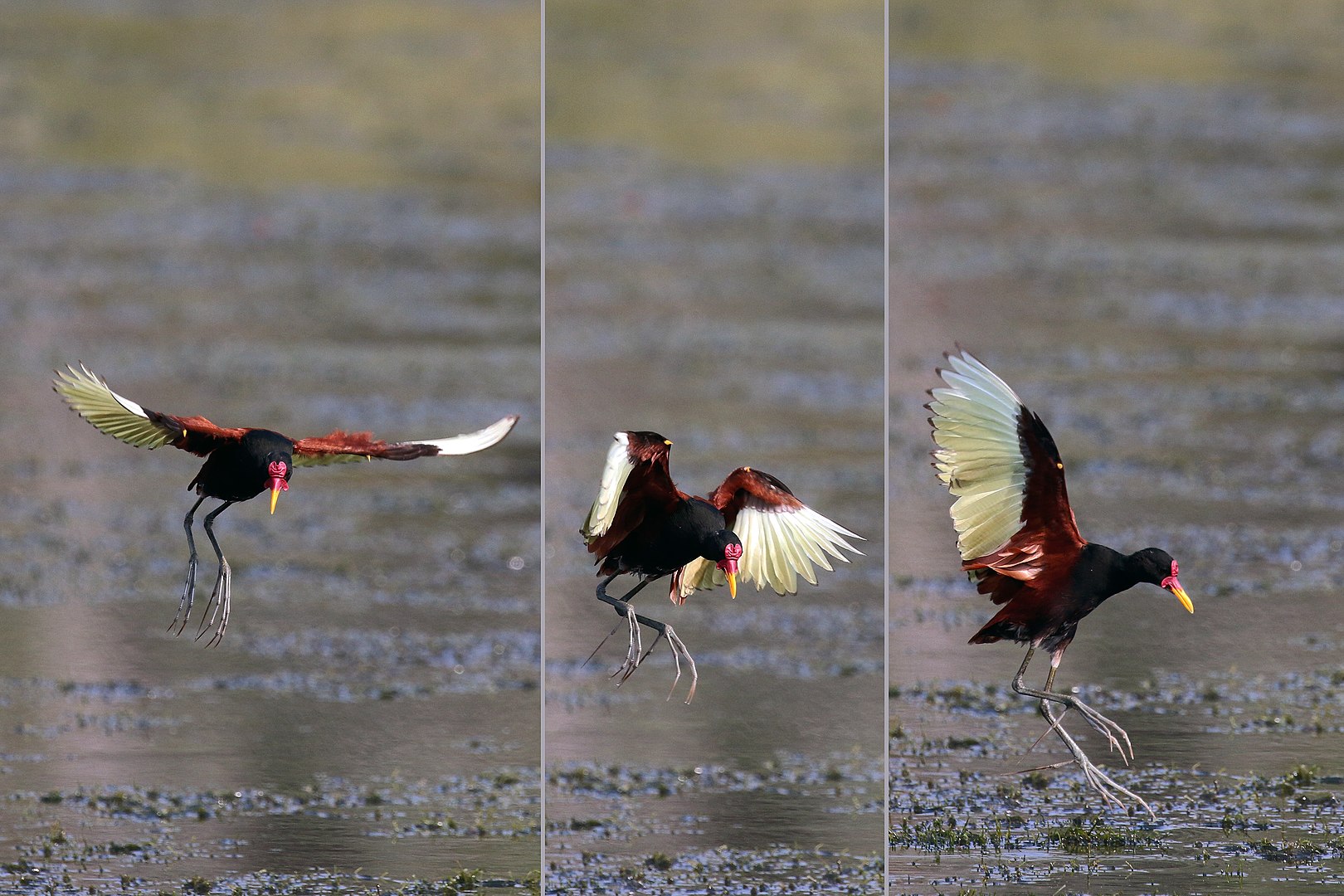The Wattled Jacana (Jacana jacana) is a common wetland bird that ranges from Panama and Trinidad and down into most of South America. In Guyana, it is known as ‘Spurwing’ and can be found in the ponds at the Botanical Gardens, the Rupununi and other wetland areas.
Sometimes called lily-trotters, they have long legs and incredibly long toes and claws. The super-long toes spread the bird’s weight over a large area. This allows them to walk across floating vegetation, especially lily pads. Jacanas often appear to be walking on the water itself! They are also good swimmers and divers, and can journey through open water from one area of vegetation to another.
Habitat Of The Wattled Jacana
Jacanas inhabit aquatic environments such as marshes or ponds in open (rather than forested) areas. They prefer water bodies that are covered in vegetation, since they use floating vegetation for both feeding and shelter. Jacanas have also been found in flooded pastures or rice fields. Jacanas are found in the Old World and New World tropics, including parts of Central America, South America (Guyana) Africa, Asia, Australia, and Madagascar.
Description Of The Wattled Jacana
The Jacana has large, bluish grey feet, which allow it to walk on top of water lilies as it forages for insects, invertebrates and seeds found on the surface vegetation. These are conspicuous and unmistakable birds. They are 17-23cm long, but the females are larger than the males. The adults have a chestnut back and wing coverts, with the rest of the body mainly black. In flight the greenish yellow flight feathers are obvious. The yellow bill extends up as a red coot-like head shield and a reddish wattle, and the legs and very long toes are dull yellow. There is a long sharp spur on the bend of the wing. Young birds initially have entirely white underparts, and can always be identified by the presence of white in their plumage.
Feeding Habits Of The Wattled Jacana
Jacanas eat primarily insects. They forage, or search for food, by floating on water lilies or other vegetation and turning over the large leafs with their long toes. They then eat the insects or seeds caught in the water lilies roots. Jacanas also forage for seeds among the blades of marsh grasses. Rarely, they will eat larger prey such as small fish.
Communication Of The Wattled Jacana
A range of noisy, rattling calls can be produced. Males have a complex range of calls to signal danger to their offspring. When they hear these sounds, chicks move closer to the male.
Behavior Of The Wattled Jacana
They can be found in flocks or communities. Predation is the major mortality factor for the young chicks. Adults will perform distraction displays to take the attention of predators off of the young. Chicks will also dive underwater with only their beak protruding in order to hide from predators, a behavior that is not commonly seen. Jacanas are able to walk on the vegetation that floats on the water due to their long legs and elongated toes that evenly distributes their weight. They are not very good fliers, but are excellent swimmers and divers.
Reproduction Of The Wattled Jacana
Breeding is polyandrous, which means that one female will mate with several males in the male’s territory. Typically four eggs, glossy brown and covered with speckles, are laid per clutch in a nest built by the male. The male then incubates the eggs and cares for the young. Once a female has laid eggs, she will fight other females to keep them from destroying her eggs and laying their own. Eggs are incubated for 20-26 days. The chicks are very precocious and learn to feed themselves very soon after hatching. Nests are built on partially submerged plants. If the nest begins to sink, or if something else is endangering the eggs, the male will pick up the eggs and carry them under his wings to a new nesting site.
Did you know?
Jacana predators include birds of prey, otters, large fish and turtles, crocodilians, and water snakes. Life can be dangerous in the wetlands!
Wattled Jacana Aka Spurwing
In Guyana, it is known as ‘Spurwing’ and can be found in the ponds at the Botanical Gardens, the Rupununi and other wetland areas. They are excellent swimmers and divers but are not so good at flying. They primarily eat insects and also seeds. These birds are truly magnificent creatures!
Article References:
- https://avibirds.com/wattled-jacana/
- https://animals.sandiegozoo.org/animals/jacana
- https://www.beautyofbirds.com/wattledjacana.html
- https://resourcelibrary.clemetzoo.com/Animal/190
- Main Image: By Charles J Sharp – Own work, from Sharp Photography, sharpphotography, CC BY-SA 4.0, https://commons.wikimedia.org/w/index.php?curid=44185195
Discover more from Things Guyana
Subscribe to get the latest posts sent to your email.







